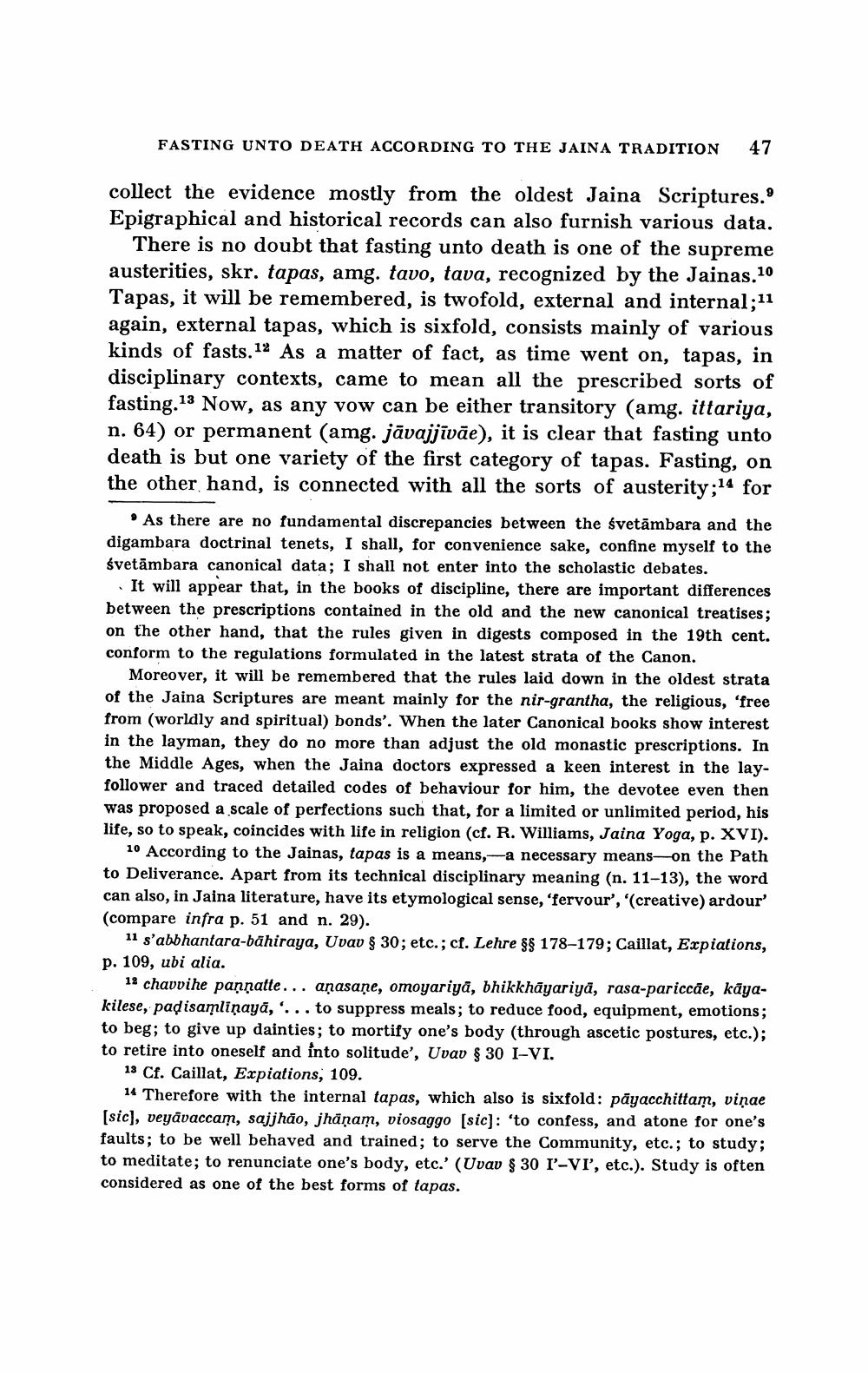Book Title: Fasting Unto Death According To Jaina Tradition Author(s): Colette Caillat Publisher: Colette Caillat View full book textPage 5
________________ FASTING UNTO DEATH ACCORDING TO THE JAINA TRADITION 47 collect the evidence mostly from the oldest Jaina Scriptures." Epigraphical and historical records can also furnish various data. There is no doubt that fasting unto death is one of the supreme austerities, skr. tapas, amg. tavo, tava, recognized by the Jainas.10 Tapas, it will be remembered, is twofold, external and internal;11 again, external tapas, which is sixfold, consists mainly of various kinds of fasts. 12 As a matter of fact, as time went on, tapas, in disciplinary contexts, came to mean all the prescribed sorts of fasting.13 Now, as any vow can be either transitory (amg. ittariya, n. 64) or permanent (amg. jāvajjīvāe), it is clear that fasting unto death is but one variety of the first category of tapas. Fasting, on the other hand, is connected with all the sorts of austerity;14 for As there are no fundamental discrepancies between the śvetambara and the digambara doctrinal tenets, I shall, for convenience sake, confine myself to the śvetämbara canonical data; I shall not enter into the scholastic debates. It will appear that, in the books of discipline, there are important differences between the prescriptions contained in the old and the new canonical treatises; on the other hand, that the rules given in digests composed in the 19th cent. conform to the regulations formulated in the latest strata of the Canon. Moreover, it will be remembered that the rules laid down in the oldest strata of the Jaina Scriptures are meant mainly for the nir-grantha, the religious, 'free from (worldly and spiritual) bonds'. When the later Canonical books show interest in the layman, they do no more than adjust the old monastic prescriptions. In the Middle Ages, when the Jaina doctors expressed a keen interest in the layfollower and traced detailed codes of behaviour for him, the devotee even then was proposed a scale of perfections such that, for a limited or unlimited period, his life, so to speak, coincides with life in religion (cf. R. Williams, Jaina Yoga, p. XVI). 10 According to the Jainas, tapas is a means,-a necessary means-on the Path to Deliverance. Apart from its technical disciplinary meaning (n. 11-13), the word can also, in Jaina literature, have its etymological sense, 'fervour', '(creative) ardour' (compare infra p. 51 and n. 29). 11 s'abbhantara-bahiraya, Uvav § 30; etc.; cf. Lehre §§ 178-179; Caillat, Expiations, p. 109, ubi alia. 12 chavvihe panṇatte... aṇasane, omoyariya, bhikkhayariya, rasa-pariccãe, kayakilese, paḍisamliņaya, '... to suppress meals; to reduce food, equipment, emotions; to beg; to give up dainties; to mortify one's body (through ascetic postures, etc.); to retire into oneself and into solitude', Uvav § 30 I-VI. 13 Cf. Caillat, Expiations, 109. 14 Therefore with the internal tapas, which also is sixfold: payacchittam, vinae [sic], veyāvaccam, sajjhão, jhāņam, viosaggo [sic]: 'to confess, and atone for one's faults; to be well behaved and trained; to serve the Community, etc.; to study; to meditate; to renunciate one's body, etc.' (Uvav § 30 I'-VI', etc.). Study is often considered as one of the best forms of tapas.Page Navigation
1 ... 3 4 5 6 7 8 9 10 11 12 13 14 15 16 17 18 19 20 21 22 23 24
